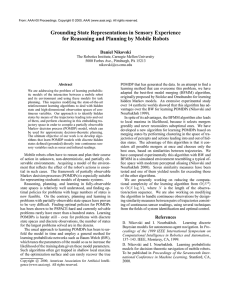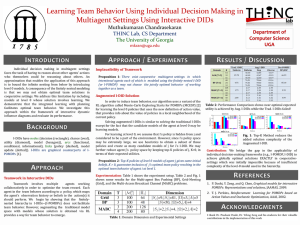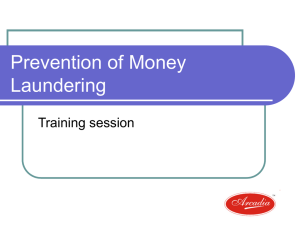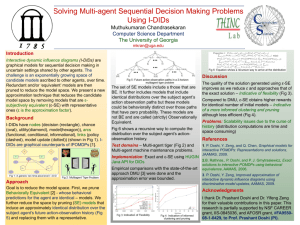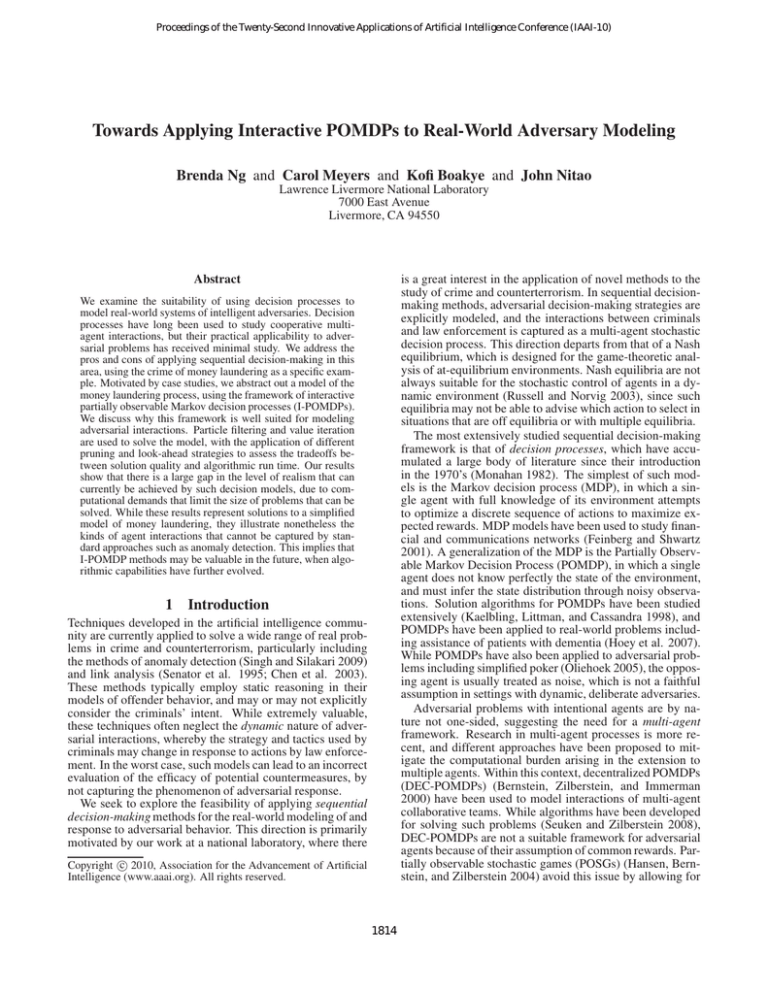
Proceedings of the Twenty-Second Innovative Applications of Artificial Intelligence Conference (IAAI-10)
Towards Applying Interactive POMDPs to Real-World Adversary Modeling
Brenda Ng and Carol Meyers and Kofi Boakye and John Nitao
Lawrence Livermore National Laboratory
7000 East Avenue
Livermore, CA 94550
is a great interest in the application of novel methods to the
study of crime and counterterrorism. In sequential decisionmaking methods, adversarial decision-making strategies are
explicitly modeled, and the interactions between criminals
and law enforcement is captured as a multi-agent stochastic
decision process. This direction departs from that of a Nash
equilibrium, which is designed for the game-theoretic analysis of at-equilibrium environments. Nash equilibria are not
always suitable for the stochastic control of agents in a dynamic environment (Russell and Norvig 2003), since such
equilibria may not be able to advise which action to select in
situations that are off equilibria or with multiple equilibria.
The most extensively studied sequential decision-making
framework is that of decision processes, which have accumulated a large body of literature since their introduction
in the 1970’s (Monahan 1982). The simplest of such models is the Markov decision process (MDP), in which a single agent with full knowledge of its environment attempts
to optimize a discrete sequence of actions to maximize expected rewards. MDP models have been used to study financial and communications networks (Feinberg and Shwartz
2001). A generalization of the MDP is the Partially Observable Markov Decision Process (POMDP), in which a single
agent does not know perfectly the state of the environment,
and must infer the state distribution through noisy observations. Solution algorithms for POMDPs have been studied
extensively (Kaelbling, Littman, and Cassandra 1998), and
POMDPs have been applied to real-world problems including assistance of patients with dementia (Hoey et al. 2007).
While POMDPs have also been applied to adversarial problems including simplified poker (Oliehoek 2005), the opposing agent is usually treated as noise, which is not a faithful
assumption in settings with dynamic, deliberate adversaries.
Adversarial problems with intentional agents are by nature not one-sided, suggesting the need for a multi-agent
framework. Research in multi-agent processes is more recent, and different approaches have been proposed to mitigate the computational burden arising in the extension to
multiple agents. Within this context, decentralized POMDPs
(DEC-POMDPs) (Bernstein, Zilberstein, and Immerman
2000) have been used to model interactions of multi-agent
collaborative teams. While algorithms have been developed
for solving such problems (Seuken and Zilberstein 2008),
DEC-POMDPs are not a suitable framework for adversarial
agents because of their assumption of common rewards. Partially observable stochastic games (POSGs) (Hansen, Bernstein, and Zilberstein 2004) avoid this issue by allowing for
Abstract
We examine the suitability of using decision processes to
model real-world systems of intelligent adversaries. Decision
processes have long been used to study cooperative multiagent interactions, but their practical applicability to adversarial problems has received minimal study. We address the
pros and cons of applying sequential decision-making in this
area, using the crime of money laundering as a specific example. Motivated by case studies, we abstract out a model of the
money laundering process, using the framework of interactive
partially observable Markov decision processes (I-POMDPs).
We discuss why this framework is well suited for modeling
adversarial interactions. Particle filtering and value iteration
are used to solve the model, with the application of different
pruning and look-ahead strategies to assess the tradeoffs between solution quality and algorithmic run time. Our results
show that there is a large gap in the level of realism that can
currently be achieved by such decision models, due to computational demands that limit the size of problems that can be
solved. While these results represent solutions to a simplified
model of money laundering, they illustrate nonetheless the
kinds of agent interactions that cannot be captured by standard approaches such as anomaly detection. This implies that
I-POMDP methods may be valuable in the future, when algorithmic capabilities have further evolved.
1 Introduction
Techniques developed in the artificial intelligence community are currently applied to solve a wide range of real problems in crime and counterterrorism, particularly including
the methods of anomaly detection (Singh and Silakari 2009)
and link analysis (Senator et al. 1995; Chen et al. 2003).
These methods typically employ static reasoning in their
models of offender behavior, and may or may not explicitly
consider the criminals’ intent. While extremely valuable,
these techniques often neglect the dynamic nature of adversarial interactions, whereby the strategy and tactics used by
criminals may change in response to actions by law enforcement. In the worst case, such models can lead to an incorrect
evaluation of the efficacy of potential countermeasures, by
not capturing the phenomenon of adversarial response.
We seek to explore the feasibility of applying sequential
decision-making methods for the real-world modeling of and
response to adversarial behavior. This direction is primarily
motivated by our work at a national laboratory, where there
c 2010, Association for the Advancement of Artificial
Copyright Intelligence (www.aaai.org). All rights reserved.
1814
P
P
where P (z|b, a) = s′ ∈S O(s′ , a, z) s∈S T (s, a, s′ )b(s).
To solve a POMDP is to find an optimal policy, which for
every achievable belief state produces an action maximizing
the agent’s expected reward.
There are two methods for solving POMDPs: value and
policy iteration. In value iteration, an optimal solution is
derived by iteratively solving for the optimal expected reward for each state, using a form of Bellman’s equations.
Conversely, in policy iteration, an improving set of policies
is generated that iteratively converges to the optimal policy, by evaluating expected rewards at each step and finding an improving policy if one exists. POMDP algorithms
that are based on variants of value iteration include Sondik’s
One-Pass (Sondik 1971) and the Witness algorithm (Littman
1996), while algorithms based on policy iteration include
Sondik’s policy iteration (Sondik 1971) and Bounded Policy Iteration (Poupart and Boutilier 2004).
different agent rewards, but exact POSG algorithms are limited to very small problems (Guo and Lesser 2006), and approximate POSG algorithms have only been developed for
common rewards (Emery-Montemerlo et al. 2004).
After examining the suitability of numerous multi-agent
models, we believe that the structure of interactive POMDPs
(I-POMDPs) (Doshi and Gmytrasiewicz 2009) is best able
to support adversary modeling. An I-POMDP is a multiagent extension of the POMDP framework, in which each
agent maintains beliefs about both the physical states of the
world and the decision process models of the other agents.
Different agent rewards are allowed, and the incorporation
of nested intent into agent beliefs allows the modeling of
agents that “game” against each other. Most importantly,
there are algorithms designed to solve I-POMDPs approximately, using both particle filtering and value iteration techniques (Doshi and Gmytrasiewicz 2009), that do not impose
the restriction of common rewards as in the DEC-POMDP
algorithms. This combination of opponent reasoning and established algorithms led to our decision to use the I-POMDP
framework.
In what follows, we describe our efforts to apply the IPOMDP model to solve a sample adversarial problem motivated by the money laundering community. We describe our
money laundering model in Section 3 , discuss implementation issues in Section 4 , and present empirical results in
Section 5 As our work represents one of the first attempts
to apply sequential decision-making to problems with dynamic adversaries, we also address the challenges that arose
in the implementation of this framework, both in terms of algorithmic improvements and model simplifications. We find
that as a whole, the computational demands of such methods
can be extreme, but the advantages of being able to model
nested intent as part of the agent model and to incorporate
this into the computed policies, make I-POMDPs an attractive approach for adversarial modeling and response.
2
2.2 Interactive POMDPs (I-POMDPs)
I-POMDPs are a generalization of POMDPs to multiple
agents that can have different (and possibly conflicting) objectives (Doshi and Gmytrasiewicz 2009). In an I-POMDP,
each agent augments its current state with the set of models
of other agents’ behaviors, to form an interactive state.
For the case of two intentional agents (i and j), agent
i’s I-POMDP with nesting level l is specified by the tuple
hIS i,l , A, Ti , Ri , Zi , Oi i:
• IS i,l = S ×Θj,l−1 is the finite set of i’s interactive states,
with IS i,0 = S; Θj,l−1 is the set of intentional models of
j, where each intentional model θj,l−1 ∈ Θj,l−1 consists
of j’s belief bj,l−1 and frame θ̂j = hA, Tj , Rj , Zj , Oj i;
• A = Ai × Aj is the finite set of joint actions;
• Ti : S × A × S → [0, 1] is the state transition function;
• Ri : IS i × A → R is i’s reward function;
• Zi is the finite set of i’s observations; and
• Oi : S × A × Zi → [0, 1] is i’s observation function.
Preliminaries
2.1 Partially Observable Markov Decision
Processes (POMDPs)
AtPeach time step, agent
a belief state bti (ist ) =
P i maintains
t−1
t−1 t−1
t−1
β ist−1 bi (is ) at−1 P (aj |θj,l−1)Oi (st, at−1, zit) ·
j
P
t−1 t
t t−1 t
Ti (st−1, at−1, st) zt P (btj,l−1|bt−1
, zj),
j,l−1, aj , zj )Oj (s , a
A POMDP describes a sequential decision-making process
of a single agent with partial observability of its environment. A POMDP is specified by hS, A, T , R, Z, Oi, where:
j
t−1
where β is a normalizing factor and P (at−1
j |θj,l−1 ) the probt−1
ability at−1
is Bayes rational for an agent modeled by θj,l−1
.
j
The belief update procedure is more complicated than in
POMDPs, because the physical state transitions depend on
both agents’ actions. To predict the next physical state, agent
i must update its beliefs about agent j’s behavior based on its
anticipation of what j observes and how j updates its belief.
This can lead to a potentially infinite nesting of beliefs, for
which it is practical to impose a finite level of nesting l.
Methods used in solving I-POMDPs include equilibriumbased methods (Doshi and Gmytrasiewicz 2006), dynamic
influence diagrams (Doshi, Zeng, and Chen 2009), and generalized point-based value iteration (Doshi and Perez 2008).
The most thoroughly documented method has been the use
of an interactive particle filter (I-PF) (Doshi and Gmytrasiewicz 2009), in conjunction with reachability tree sampling, which led us to select this technique for our problem.
• S is the finite set of physical states in the environment;
• A is the finite set of possible actions;
• T : S × A × S → [0, 1] is the state transition function,
T (s, a, s′ ) = P (s′ |s, a), that defines the probability of
ending in state s′ if action a is taken in state s;
• R : S × A → R is the reward function, R(s, a), that
defines the reward of taking action a in state s;
• Z is the finite set of possible observations; and
• O : S × A × Z → [0, 1] is the observation function,
O(s′ , a, z) = P (z|a, s′ ), that defines the probability of
observing z if action a is taken, resulting in state s′ .
At each time step, the agent updates its belief state bt (s′ ),
which defines the probability of being in each state s′ given
its history of actions and observations. Formally,
P
O(s′ , at−1 , z t ) s∈S T (s, at−1 , s′ )bt−1 (s)
t ′
,
b (s ) =
P (z t |bt−1 , at−1 )
1815
2.3
Money Laundering
Joint physical states are defined as s = {redM oneyLoc,
blueSensorLoc}. The Red Team states represent accounts
where money could be held, and the Blue Team states represent potential sensor locations. Specifically, the Red Team
has 11 possible states: {dirty pot, bank accounts, insurance,
securities, offshore accounts, shell companies, trusts, corporate loans, casino accounts, real estate, clean pot}. The Blue
Team has 9 sensor locations: {no sensors, bank accounts, insurance, securities, shell companies, trusts, corporate loans,
casino accounts, real estate}. There are thus 99 joint states.
This model presupposes that each team can only occupy
one state at a given time. This was a major concession from
our early model, in which the Red and Blue Team’s assets
could be spread among states. Unfortunately, such flexibility
caused the state space to increase exponentially, and current
I-POMDP algorithms simply could not solve it.
Money laundering is a crime often involving a complex series of transactions and financial institutions from different
jurisdictions. This crime is also very pervasive: estimates
suggest that at least 2% of the global gross domestic product is comprised of money laundering activities (Buchanan
2004). Law enforcement has described this laundering as a
three-step process (United States Treasury 2002):
Placement: Physical ‘dirty’ currency enters the financial system. This is the most vulnerable point in the
process, as it involves the conversion of large amounts
of cash. Common targets of placement include domestic bank accounts, insurance products, and securities.
Layering: Creation of a web of financial transactions
to obscure the source of the money. Types of layering
include transfers to offshore accounts, shell companies,
and trusts. By making numerous transactions in different jurisdictions, the paper trail becomes hard to follow.
Integration: Reintroduction of the laundered money
to the mainstream economy. This is done by mingling
laundered money with funds from legitimate businesses, including real estate, loans, or casinos. This can
be hard to detect unless a paper trail has been formed.
3.2 Actions and Observations
In this section, we describe the sample money laundering
problem used in our feasibility study. We begin by noting that this problem has had to be downscaled dramatically
from our original designs to ensure tractability. Throughout
this section and Section 5 , we discuss the modeling tradeoffs that had to be made to ensure solvability of the problem.
Analogous to real-world money laundering, the Red Team
has four primary actions: {Placement, Layering, Integration, Listening}. The Placement action transitions the Red
Team from the dirty pot to the ‘placement states’ of bank
accounts, insurance, or securities, with equal probability. If
Red’s money is in a placement state, then the Layering action can move the assets among the placement states or into
the ‘layering states’, which are offshore accounts, shell companies, and trusts. If Red’s money is in a layering state, then
the Layering action can move the assets among the layering states, or into the ‘integration states’ of corporate loans,
casino accounts, and real estate. Finally, the Integration action transitions the integration states to the Red Team’s clean
pot with a fixed probability. The Listening action enables the
Red Team to gather noisy intelligence on Blue’s location.
Most of the Blue Team’s actions relate to sensor placements; in particular, there is a corresponding action for placing sensors at each of the 8 locations listed in the Blue
Team’s states. The Blue Team also has a special action, Confiscation, in which it attempts to seize the Red Team’s assets
if it believes that both teams occupy the same physical state.
In terms of observations, the Red Team can obtain evidence of the Blue Team’s presence at a given number of
locations (banks, shell companies, and casino accounts) by
executing the Listening action from that state. The Blue
Team observes the Red Team via reports (such as SARs)
from most locations (except dirty pot, clean pot, offshore
accounts, and shell companies). The Blue Team can also
receive observations from its sensors to supplement information gained from the reports.
Currently, the transition and observation probabilities are
populated by the ‘best guess’ ideas of our team. Ideally,
these probabilities might be derived by Bayesian reinforcement learning techniques. As part of future work, it might
be possible to adopt ideas from Bayes-adaptive POMDPs
(Ross, Chaib-draa, and Pineau 2007) to learn these probabilities, but this is beyond the scope of our current study.
3.1
3.3 Rewards and Termination Conditions
In recent years, significant legislation has been introduced
in the US to detect money laundering activity (United States
Treasury 2002). The Bank Secrecy Act (BSA) requires
banks and other institutions to file Suspicious Activity Reports (SARs) on transactions that they suspect might involve
money derived from illegal activity. In addition, any transaction of more than $10,000 automatically generates a Currency Transaction Report (CTR). These reporting requirements have been invaluable in helping trace money laundering activities, though the question still remains of how best
to sort through massive amounts of BSA report data.
There has been some previous work on using data mining to find evidence of money laundering activity (Office of
Technology Assessment 1995). This work has been primarily in the areas of clustering and link analysis (Zhang,
Salerno, and Yu 2003), and such algorithms have been employed in tools used by the US Financial Crimes Enforcement Network (Goldberg and Senator 1998). To our knowledge, sequential decision-making techniques are not currently being used to model or assess money laundering.
Thus, this work represents a first step in a novel direction.
3 A Sample Adversarial Problem:
an I-POMDP of Money Laundering
Agents and Joint States
The agents in our model are the Red Team (money launderers) and the Blue Team (law enforcement). The Red Team’s
goal is to evade capture while moving assets from a ‘dirty’
pot to a ‘clean’ pot in a financial network, while the Blue
Team’s goal is to find and confiscate assets of the Red Team.
The reward function formalizes the game progress and termination conditions. Specifically, there is a reward (penalty)
of 100 to the Red Team (Blue Team) for evading capture
and reaching the clean pot; conversely, there is a penalty (reward) of 100 to the Blue Team (Red Team) for apprehending
1816
the money launderer. In addition, the Listening action by the
Red Team incurs a penalty of 20, provided that the Red team
is not caught during that turn. The Blue Team experiences
a penalty of 25 for a mistaken confiscation (occurring when
Red’s assets and Blue’s sensors are at different locations,
and the Confiscation action is taken). All other actions have
a penalty of 10, to ensure the game does not stall. We experimented with a range of values for rewards/penalties while
maintaining their ordinality (i.e., the stall penalty being less
than the misconfiscation penalty, which in turn is less than
the misapprehension penalty, etc.) and have found that the
results were not sensitive to the specific values chosen.
In a more realistic game, a money launderer might be able
to lose only part of their money, and law enforcement might
apprehend only part of a criminal ring. These features were
also sacrificed to ensure a manageable number of states.
3.4
Figure 1: In I-PF, sampling is recursively performed for each
level of beliefs. Agent k updates its beliefs based on its anticipation of the other agent’s observations, actions, and model
updates. This requires updating the other agent’s beliefs,
leading to particle filtering on its beliefs. Image adopted
from (Doshi and Gmytrasiewicz 2009).
Comparison with Benchmark Problems
Table 1 compares the size of our problem with three benchmark problems documented and solved using I-POMDPs
(see (Doshi and Gmytrasiewicz 2009) for details about the
benchmark problems).
Table 1: Size Comparison of Problems Solved by I-POMDPs
new particles. This weight is based on the probability of
obtaining the associated observations given the interactive
state of the particle and the actions of each agent. A set of
N particles is then resampled according to these importance
weights and returned as the output of the algorithm.
States Actions Observations Problem size
|S| |Ai | × |Aj | |Zi | × |Zj |
(product)
Tiger
2
3×3
6×6
648
3
4×4
2×2
192
Machine
UAV
36
5×5
3×3
8100
99
4×9
4 × 11
156,816
ML (ours)
Problem
4.2 Reachability Tree Sampling
Thus, even after downscaling, the size of our money laundering problem is much larger (by nearly 20 times) than anything previously solved by I-POMDPs. It is our hope that
progress on this problem will shed light on bridging the gap
between the theory and practice of applying I-POMDPs.
4
4.1
While the I-PF approach addresses the curse of dimensionality due to the complexity of the belief state, the curse of
history can also be problematic, because the complexity of
policies increases with the horizon length. Here, value iteration requires the construction of a reachability tree as
part of its reachability analysis. With increasing horizons,
this reachability tree grows exponentially to account for every possible sequence of actions and observations during
the course of the decision process. To address this issue,
(Doshi and Gmytrasiewicz 2009) proposed reachability tree
sampling (RTS) as a way to reduce the branching factor of
this tree. In RTS, one samples observations according to
zit ∼ P (Zi |at−1
, b̃t−1
i
k,l ) and builds a partial reachability tree
based on the samples and the complete set of actions.
In our money laundering problem, the curse of history required approximations beyond the standard RTS to address a
major computational bottleneck: the construction of the opposing agent’s reachability tree. As mentioned previously,
in order for agent k to behave optimally, it must anticipate
what action −k might take. Thus, in solving for k’s optimal
policy, it must also construct −k’s reachability tree and use
it to find −k’s optimal action. As the size of this tree grows
as O((|A−k ||Z−k |)l ), it becomes large very quickly. In our
model (Table 1), this presented a major computational hurdle.
To solve our money laundering model, it was necessary
to prune not only the agent’s reachability tree, but also the
opposing agent’s reachability tree. To do so, we introduced
two approximations in particular: (1) RTS on −k’s reachability tree, thus reducing its tree’s breadth; and (2) limited
look-ahead for −k, thus reducing its tree’s depth. These are
reasonable approximations under a resource-constrained environment. For the first strategy, our modified RTS algo-
I-POMDP Algorithms
Interactive Particle Filter (I-PF)
Introduced by (Doshi and Gmytrasiewicz 2009), the interactive particle filter extends the standard particle filter to
multi-agent state estimation within an I-POMDP. Analogous
to the stardard particle filter, I-PF alternates between importance sampling and selection, inheriting the same convergence properties. In the following discussion, we use k to
represent either agent i or j, and −k for the other agent.
The I-PF for agent k starts with a set of N samples or particles, b̃t−1
k,l , that approximates agent k’s belief state. These
particles are generated by recursively sampling from the
nested beliefs that comprise the belief state.
The algorithm proceeds by propagating each particle forward in time. This operation requires an estimate of agent
−k’s action, since state transitions are dependent on joint actions. To infer −k’s action, its policy must be derived from
its belief state. This, in turn, requires a recursive invocation
of the particle filter for each of the nesting levels (Figure
1). Recursion terminates at level 1, where agent k uses a
POMDP belief update to infer −k’s level-0 belief.
The propagation step generates a total of |Z−k |N particles, consisting of N particles for each possible observation
of the other agent. Once this step has been completed, the algorithm assigns an importance weight to each of the |Z−k |N
1817
rithm uses NZk observation samples to construct k’s reachability tree and NZ−k observation samples to construct −k’s
reachability tree. For the second strategy, our modified algorithm truncates the construction of −k’s reachability tree
at a prespecified look-ahead depth.
5 Empirical Results
Up to this point, we have discussed ways to make the algorithms tractable. However, the feasibility of these algorithms
is best reflected in the quality of the policies computed. Simulations provide a natural way to evaluate these policies. In
what follows, we present simulation results based on the
policies computed by I-PF along with our modified RTS.
Our simulations start with all particles in the hDirty-pot,
No-sensori state and the level-0 opponent belief initialized
with all its probability mass in that same state. Each agent
computes a policy using the modified RTS, based on a planning horizon of h for itself and an opponent horizon o for its
opinion of the opponent’s horizon. The agents execute their
computed policies over a number of turns based on their
planning horizons, accruing a reward or penalty at each turn.
Thereafter, each agent repeats its planning; the updated prior
belief for this new round is obtained from the leaf node of the
reachability tree corresponding to the actions and observations in the last round. Due to the sampling of observations
in RTS, if this leaf node does not have an updated belief, the
most recently updated node in the path from the root node
to the leaf is used as an alternative. This process repeats
until one agent reaches a termination condition. (Thus, the
number of turns can vary between different simulations.)
For each agent k, there are five tunable parameters that
can affect the quality of the computed policy: (1) the faithfulness of belief representation in terms of the number of
particles N ; (2) the horizon h in which planning is based
(i.e., how many steps of look-ahead k uses in deciding its
action); (3) the breadth of each horizon (i.e., how broad is
the action/observation space at each depth of k’s reachability
tree), controlled by NZk ; (4) the assumed planning horizon
o of the opponent (i.e., k’s assumption of −k’s look-ahead);
and (5) the assumed breadth of the opponent (i.e., k’s assumption of breadth in −k’s reachability tree), controlled by
NZ−k . The influence of these parameters on the computed
policies has practical relevance to real-world applications, in
terms of both the quality of policies produced and the sensitivity of each player to its assumptions about its opponent.
As such, we seek to answer the following questions:
1. Given the asymmetry of our problem, which agent is at a
more advantageous position under the same parameters?
2. What change in parameters, if any, can alter this position?
3. In a resource-bounded computational environment, which
change gives more improvement to the policy: making the
belief more accurate, or planning with a longer horizon?
These questions illustrate the merits of using a decision process approach to adversarial problems: the information obtained from this analysis easily allows for model refinement
in a manner not possible in anomaly detection, for example.
5.1
Figure 2: Blue Team Performance in Simulation Experiments
Figure 3: Red Team Performance in Simulation Experiments
NZk = 4, NZ−k = 4. In particular, both agents are assumed equal with respect to approximations in their belief
states and reachability trees. The disparity in the planning
horizons (h > o) represents a common assumption that each
agent “thinks” it is superior to its adversary in terms of planning. In general, we were not as interested in the exact values of this baseline case as in the effects of deviating from
some set of baseline parameters; as such, these choices were
influenced in part by the need for reasonable execution time.
For all experiments, results were based on 50 trials. Baseline results appear as the first boxplot (E1) in Figures 2-4.
Figure 2 gives the Blue Team reward, Figure 3 the Red Team
reward, and Figure 4 the number of turns simulated. Figures
2 and 3 show that on average, Red’s reward exceeds Blue’s,
and thus Red has an advantage for these parameter values.
The next five boxplots (experiments E2-E7) in Figures 2-4
show results addressing the second question. In each experiment, one of the baseline parameters was varied to allocate
more resources to the Blue Team. In E2, the Blue Team’s
number of particles N was increased to 25; in E3, the Red
Team’s planning horizon h was reduced to 2; in E4, the Red
Team’s opponent horizon o was reduced to 1; in E5, the Blue
Team’s NZk was increased to 16; and in E6, the Blue Team’s
Simulation Results
To answer our first question, a baseline experiment was performed. In this experiment, the parameters were the same
for both agents and were as follows: N = 10, h = 3, o = 2,
1818
6
Our work represents a first step towards the use of sequential
decision-making methods in real adversarial settings. With
the I-POMDP framework, we are able to model adversarial
interactions at a level of fidelity not possible in traditional
techniques used in crime and counterterrorism. In particular,
traditional techniques typically treat the adversary as fixed
and/or as noise, employing static methods such as clustering
and outlier detection, to merely identify adversarial effects.
In contrast, we capture the dynamic nature of these interactions as a multi-agent decision process in which strategies
and tactics can change over time, and we are able to compute
the best response given the evidence presented so far.
While there has been some work addressing dynamic adversaries via methods other than I-POMDPs, none has tackled this problem with as much “dynamicity” as this paper.
(Dalvi et al. 2004) frames the problem of a dynamic spammer as a classification problem in which a learner is presented with a tampered distribution of instances where some
spam instances are transformed into non-spam instances by
word addition or synonym usage. However, this work captures only one-shot interaction between the spammer and
the learner, and does not capture adaptivity adopted by the
spammer and/or learner upon repeated interactions. (Tan
and Cheng 2009) examined games where the environment
can be decomposed into constituent POMDP and MDP components, where the POMDP corresponds to the adversary
player’s model and the MDP is the rest of the perfectly observable world, as in the game of tennis. This work presupposes that the POMDP component is much smaller than the
MDP component, hence circumventing some of the computational overhead associated with POMDPs. However, while
this type of convenient structure may manifest in the controlled environments of virtual games, it is rarely applicable
in real-world domains. In sum, the applicability of these
ideas are yet to be seen as feasible for modeling of realworld situations of the kind explored in this paper.
While we recognize that our model is far from the actual
and complex process of money laundering, we find this exercise to be useful in illustrating the computational challenges
that first need to be addressed before I-POMDPs can be
deployed in real security-related, adversarial applications.
Moreover, we note that our abstract model is sufficiently
general to be applicable to other real-world problems beyond
the domain of money laundering; it is a representative of a
generic class of problems in adversarial search and pursuit,
and thus our findings can be extended to this larger domain.
Our findings show that the computational bottleneck in
solving I-POMDPs is in the construction of the agents’
reachability trees. In this work, we pruned the reachability trees via sampling. Alternatively, we might be able to
exploit the problem structure to streamline the construction
of reachability trees via distributed processing. However,
this would require a more thorough future investigation and
its implementation might be problem-dependent. Thus, one
direction for making I-POMDPs more widely applicable for
adversarial modeling would be to mitigate the computational
burden through algorithmic approximations (approach taken
in this work) and/or exploitation of problem structure.
Another direction for future research would be to relax
the assumption that the model is known a priori. As part
of current ongoing work, we are extending the I-POMDP
Figure 4: Number of Turns per Simulation
NZ−k was increased to 16. We observe that a noticeable difference occurs only in E4, and even here the difference is
not sufficient to shift the advantage towards the Blue Team.
Such a shift in advantage does occur in the final experiment, E7. Here, the opponent horizon o for both Blue and
Red is set to 1. This corresponds to the situation where both
players are myopic in the assessment of their opponents,
leading to an imbalance in the sophistication levels of the
strategies produced. We can account for this anomalous shift
by inspecting the particle distributions for the nodes in the
reachability tree; our analysis reveals that the entropy of all
nodes for the Blue Team’s model is at or near zero in all experiments except E7, leading to the policy of repeated identical sensor placement in those cases. In such a situation, allocating resources towards improving the belief accuracy is of
little benefit, providing insight to our third question above.
By reducing Blue’s opponent horizon, a policy involving the
Confiscation action emerges, allowing Blue the opportunity
to win. In addition, Blue’s victories appear to be quick, as
evidenced by the significantly reduced number of turns in
such simulations (see Figure 4).
5.2
Computational Findings
We note that the computational demands were extreme in
solving even our simplified model. Table 2 displays the run
times for different numbers of particles and horizon lengths.
In all runs, we assume o = 3, and NZk = NZ−k = 4. The
machine used is a Mac Pro with two 2.93GHz quad-core
Intel Xeon processors and 16.0GB of RAM, running OS X.
Table 2: Run Times for Solving the I-POMDP, in Seconds.
5 particles
10 particles
50 particles
h=2
31
64
428
h=3
930
1774
8998
h=4
16602
33968
*
Conclusions
h=5
*
*
*
Entries of the table indicated with a ∗ did not solve within
a specified cutoff time of 24 hours. We observe that even
for relatively small opponent horizon lengths and numbers
of particles, the model can take an extremely long time to
solve. This finding was the primary motivation behind the
downscaling of our original money laundering problem.
1819
framework to incorporate Bayesian reinforcement learning,
such that the transition and observation models are inferred
in conjunction with the state, in a sequential manner analogous to the framework of Bayes-Adaptive POMDPs (Ross,
Chaib-draa, and Pineau 2007). This will be an important
step in making I-POMDP applications more practical since
it is unrealistic to assume complete and exact knowledge
of the adversary’s parameters, or that these parameters stay
fixed and do not change over time. Incorporating reinforcement learning will make the task of I-POMDP modeling
more faithful to the actual adversarial process as it happens.
Despite the current limitations of I-POMDP algorithms,
we feel that the framework itself is still very promising because an I-POMDP can (1) model agents with both adversarial and cooperative objectives, and (2) incorporate nested
intent as part of the agent’s model. The aspect of nested intent is especially relevant in modeling human agents, who
arguably employ nested strategies in adversarial situations
naturally. While the technology of I-POMDPs has not yet
evolved to address realistic-sized problems (involving hundreds or thousands of states, actions and/or observations),
we are optimistic that, with future advances, I-POMDPs will
eventually be applicable for real-world deployment.
Feinberg, E., and Shwartz, A. 2001. Handbook of Markov Decision
Processes: Methods and Applications. International Series in OR
and Management Science. Springer.
Goldberg, H., and Senator, T. 1998. The FinCEN AI system:
finding financial crimes in a large database of cash transactions.
In Agent Technology: Foundations, Applications, and Markets.
Springer-Verlag. Chapter 15.
Guo, A., and Lesser, V. 2006. Stochastic planning for weakly
coupled distributed agents. In Proceedings of the 5th AAMAS Conference, 326–328. Hakodate, Japan: ACM.
Hansen, E.; Bernstein, D.; and Zilberstein, S. 2004. Dynamic
programming for partially observable stochastic games. In Proceedings of the 19th AAAI Conference, 709–715. San Jose, CA:
AAAI.
Hoey, J.; von Bertoldi, A.; Poupart, P.; and Mihailidis, A. 2007.
Assisting persons with dementia during handwashing using a partially observable Markov decision process. In Proceedings of the
5th ICVS Conference.
Kaelbling, L.; Littman, M.; and Cassandra, A. 1998. Planning
and acting in partially observable stochastic domains. Artificial
Intelligence 101:99–134.
Littman, M. 1996. Algorithms for Sequential Decision Making.
PhD Dissertation, Brown University.
Monahan, G. 1982. A survey of partially observable Markov decision processes: Theory, models, and algorithms. Management
Science 28(1):1–16.
Office of Technology Assessment, U. C. 1995. Information Technologies for the Control of Money Laundering. OTA-ITC-630. US
Government Printing Office.
Oliehoek, F. 2005. Game theory and AI: a unified approach to
poker games. Masters Thesis, University of Amsterdam.
Poupart, P., and Boutilier, C. 2004. Bounded finite state controllers.
In Proceedings of the 17th NIPS Conference, 823–830. Vancouver,
BC, Canada: MIT Press.
Ross, S.; Chaib-draa, B.; and Pineau, J. 2007. Bayes-adaptive
POMDPs. In Proceedings of the 21st NIPS Conference. Vancouver,
British Columbia, Canada: MIT Press.
Russell, S., and Norvig, P. 2003. Artificial Intelligence: A Modern
Approach. Prentice-Hall, Englewood Cliffs, NJ, 2nd edition.
Senator, T.; Goldberg, H.; Wooton, J.; Cottini, M.; Khan, A.;
Klinger, C.; Llamas, W.; Marrone, M.; and Wong, R. 1995. The
FinCEN artificial intelligence system: identifying potential money
laundering from reports of large cash transactions. In Proceedings
of the 7th IAAI Conference, 156–170. Montreal, Quebec: AAAI.
Seuken, S., and Zilberstein, S. 2008. Formal models and algorithms for decentralized decision making under uncertainty. Autonomous Agents and Multi-Agent Systems 17(2):1387–2532.
Singh, S., and Silakari, S. 2009. A survey of cyber attack detection
systems. International Journal of Computer Science and Network
Security 9(5):1–10.
Sondik, E. 1971. The Optimal Control of Partially Observable
Markov Decision Processes. PhD Dissertation, Stanford University.
Tan, C., and Cheng, H. 2009. IMPLANT: An integrated MDP and
POMDP learning agent for adaptive games. In Proceedings of the
5th AIIDE Conference, 94–99. Stanford, CA: AAAI.
United States Treasury. 2002. Money laundering: A banker’s guide
to avoiding problems. Technical report, Office of the Comptroller
of the Currency, US Treasury.
Zhang, Z.; Salerno, J.; and Yu, P. 2003. Applying data mining in
investigating money laundering crimes. In Proceedings of the 9th
ACM SIGKDD Conference, 747–752. Washington, DC: ACM.
Acknowledgements
This work was performed under the auspices of the U.S. Department of Energy by Lawrence Livermore National Laboratory (LLNL) under Contract DE-AC52-07NA27344, and
was supported by LLNL funding for the project Towards
Understanding Higher-Adaptive Systems (09-LW-30). The
authors also wish to thank Prashant Doshi for his helpful
advice and starter source code.
References
Bernstein, D.; Zilberstein, S.; and Immerman, N. 2000. The complexity of decentralized control of Markov decision processes. In
Proceedings of the 16th UAI Conference, 32–37. Stanford, CA:
Morgan Kaufmann.
Buchanan, B. 2004. Money laundering: a global obstacle. Research in International Business and Finance 18:115–127.
Chen, H.; Zeng, D.; Atabakhsh, H.; Wyzga, W.; and Schroeder,
J. 2003. Coplink: mining law enforcement data and knowledge.
Communications of the ACM 46(1):28–34.
Dalvi, N.; Domingos, P.; Mausam; Sanghai, S.; and Verma, D.
2004. Adversarial classification. In Proceedings of the 10th ACM
SIGKDD Conference, 99–108. Seattle, WA: ACM.
Doshi, P., and Gmytrasiewicz, P. 2006. On the difficulty of achieving equilibrium in interactive POMDPs. In Proceedings of the 21st
AAAI Conference. Boston, MA: AAAI.
Doshi, P., and Gmytrasiewicz, P. 2009. Monte Carlo sampling
methods for approximating Interactive POMDPs. Journal of Artificial Intelligence Research 34:297–337.
Doshi, P., and Perez, D. 2008. Generalized point-based value iteration for interactive POMDPs. In Proceedings of the 23rd AAAI
Conference, 63–68. Chicago, IL: AAAI.
Doshi, P.; Zeng, Y.; and Chen, Q. 2009. Graphical models for
interactive POMDPs: representations and solutions. Autonomous
Agents and Multi-Agent Systems 18(3):376–416.
Emery-Montemerlo, R.; Gordon, G.; Schneider, J.; and Thrun, S.
2004. Approximate solutions for partially observable stochastic
games with common payoffs. In Proceedings of the 3rd AAMAS
Conference, 136–143. New York, NY: IEEE.
1820

